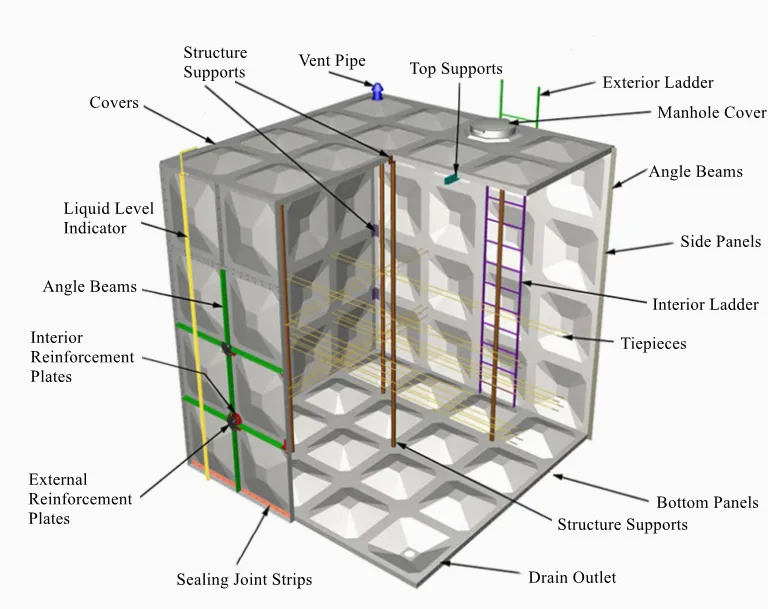loading...
- No. 9, Xingyuan South Street, Dongwaihuan Road, Zaoqiang County, Hengshui, Hebei, China
- admin@zjcomposites.com
- +86 15097380338
- Welcome to visit our website!
Specification Guidelines for GRP Grating Design and Performance Standards
Understanding GRP Grating Specification
GRP (Glass Reinforced Plastic) grating has become increasingly popular in various industries due to its unique properties and advantages compared to traditional materials. This article will explore the specifications of GRP grating, its applications, and the factors that make it an appealing choice for many engineering and construction projects.
What is GRP Grating?
GRP grating is a composite material made from a polymer matrix reinforced with glass fibers. This combination results in a lightweight yet robust material, perfect for a variety of applications where strength, durability, and resistance to corrosion are required. GRP grating is often used in environments that expose materials to harsh chemicals, moisture, and mechanical stress.
Key Specifications of GRP Grating
1. Load Bearing Capacity One of the most crucial specifications for GRP grating is its load-bearing capacity, which is often classified according to various standards. Load ratings typically range from light-duty for pedestrian traffic to heavy-duty for industrial applications. The specific load capacity will depend on the thickness of the grating, the spacing of the support beams, and the type of resin used in its manufacture.
2. Dimensions GRP grating comes in various thicknesses, widths, and lengths, allowing for customization based on project requirements. Common thicknesses range from 25 mm to 50 mm, while widths can vary to accommodate different spans between supports. Understanding the dimensions is essential for ensuring compatibility with existing infrastructure and meeting safety regulations.
3. Chemical Resistance GRP grating is designed to withstand exposure to a wide range of chemicals. The choice of resin—whether epoxy, polyester, or vinyl ester—will determine the level of chemical resistance. Specifications should detail the types of chemicals the grating can resist, making it suitable for applications in chemical processing plants, wastewater treatment facilities, and food processing environments.
grp grating specification

4. Surface Finish The surface finish of GRP grating is another essential specification. It can be manufactured with a slip-resistant surface, making it safer for foot traffic and reducing the risk of accidents in wet or oily conditions. Manufacturers often provide different surface textures, including serrated or embossed finishes, to enhance traction.
5. Fire Resistance Fire performance is another important aspect of GRP grating specifications. The material can be treated with fire-retardant additives to improve its performance in case of a fire. Compliance with relevant fire safety standards is crucial, particularly in sectors such as manufacturing and construction.
6. Color and Aesthetics GRP grating is available in various colors, allowing for aesthetic customization and color-coding for specific applications. This versatility makes it applicable not just for functional use but also for enhancing the visual aspect of a project.
Applications of GRP Grating
Due to its impressive properties, GRP grating finds utility in various industries. Common applications include
- Water Treatment Facilities Offering corrosion resistance against harsh chemicals used in the treatment processes. - Walkways and Platforms Providing safe, slip-resistant surfaces in industrial environments. - Marine Structures Ideal for docks and piers that require materials resistant to saltwater corrosion. - Food Processing Ensuring hygiene and easy cleaning while withstanding high temperatures and chemical treatments.
Conclusion
GRP grating has established itself as a versatile and reliable material choice for many applications. Its specifications, encompassing load capacity, dimensions, chemical resistance, fire safety, and aesthetics, make it suitable for a diverse range of environments. Understanding these specifications is critical for engineers and project managers when choosing the right grating solution to meet their specific needs and ensure safety and durability in their projects. With emerging technologies and innovations, the future of GRP grating looks promising, further solidifying its role in modern construction and industrial applications.
-
GRP Structures: The Future of Lightweight, High-Performance EngineeringNewsJun.20,2025
-
FRP Water Tank: High-Performance Storage for Corrosive and Clean Water SystemsNewsJun.20,2025
-
FRP Square Tube: The New Industry Standard for Chemical and Structural ApplicationsNewsJun.20,2025
-
FRP Pultruded Profiles: The Ultimate Choice for Lightweight Structural StrengthNewsJun.20,2025
-
FRP Handrails: The Safer, Smarter, and Stronger Choice for Modern InfrastructureNewsJun.20,2025
-
FRP Grating: The Smart Solution for Durable, Lightweight Industrial FlooringNewsJun.20,2025
-
Why Choose a Galvanized Water Tank for Your Storage NeedsNewsMay.21,2025
